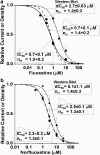Drug-induced long QT syndrome: hERG K+ channel block and disruption of protein trafficking by fluoxetine and norfluoxetine
- PMID: 16967046
- PMCID: PMC2014667
- DOI: 10.1038/sj.bjp.0706892
Drug-induced long QT syndrome: hERG K+ channel block and disruption of protein trafficking by fluoxetine and norfluoxetine
Abstract
Background and purpose: Fluoxetine (Prozac) is a widely prescribed drug in adults and children, and it has an active metabolite, norfluoxetine, with a prolonged elimination time. Although uncommon, Prozac causes QT interval prolongation and arrhythmias; a patient who took an overdose of Prozac exhibited a prolonged QT interval (QTc 625 msec). We looked for possible mechanisms underlying this clinical finding by analysing the effects of fluoxetine and norfluoxetine on ion channels in vitro.
Experimental approach: We studied the effects of fluoxetine and norfluoxetine on the electrophysiology and cellular trafficking of hERG K+ and SCN5A Na+ channels heterologously expressed in HEK293 cells.
Key results: Voltage clamp analyses employing square pulse or ventricular action potential waveform protocols showed that fluoxetine and norfluoxetine caused direct, concentration-dependent, block of hERG current (IhERG). Biochemical studies showed that both compounds also caused concentration-dependent reductions in the trafficking of hERG channel protein into the cell surface membrane. Fluoxetine had no effect on SCN5A channel or HEK293 cell endogenous current. Mutations in the hERG channel drug binding domain reduced fluoxetine block of IhERG but did not alter fluoxetine's effect on hERG channel protein trafficking.
Conclusions and implications: Our findings show that both fluoxetine and norfluoxetine at similar concentrations selectively reduce IhERG by two mechanisms, (1) direct channel block, and (2) indirectly by disrupting channel protein trafficking. These two effects are not mediated by a single drug binding site. Our findings add complexity to understanding the mechanisms that cause drug-induced long QT syndrome.
Figures








Comment in
-
Combined hERG channel inhibition and disruption of trafficking in drug-induced long QT syndrome by fluoxetine: a case-study in cardiac safety pharmacology.Br J Pharmacol. 2006 Nov;149(5):457-9. doi: 10.1038/sj.bjp.0706890. Epub 2006 Sep 11. Br J Pharmacol. 2006. PMID: 16967047 Free PMC article.
Similar articles
-
Combined hERG channel inhibition and disruption of trafficking in drug-induced long QT syndrome by fluoxetine: a case-study in cardiac safety pharmacology.Br J Pharmacol. 2006 Nov;149(5):457-9. doi: 10.1038/sj.bjp.0706890. Epub 2006 Sep 11. Br J Pharmacol. 2006. PMID: 16967047 Free PMC article.
-
Coexistence of hERG current block and disruption of protein trafficking in ketoconazole-induced long QT syndrome.Br J Pharmacol. 2008 Feb;153(3):439-47. doi: 10.1038/sj.bjp.0707537. Epub 2007 Oct 29. Br J Pharmacol. 2008. PMID: 17965736 Free PMC article.
-
The binding site for channel blockers that rescue misprocessed human long QT syndrome type 2 ether-a-gogo-related gene (HERG) mutations.J Biol Chem. 2002 Feb 15;277(7):4989-98. doi: 10.1074/jbc.M107345200. Epub 2001 Dec 10. J Biol Chem. 2002. PMID: 11741928
-
QT interval prolongation and cardiac risk assessment for novel drugs.Curr Opin Investig Drugs. 2003 Mar;4(3):303-8. Curr Opin Investig Drugs. 2003. PMID: 12735231 Review.
-
hERG channel trafficking: novel targets in drug-induced long QT syndrome.Biochem Soc Trans. 2007 Nov;35(Pt 5):1060-3. doi: 10.1042/BST0351060. Biochem Soc Trans. 2007. PMID: 17956279 Review.
Cited by
-
Rab11-dependent Recycling of the Human Ether-a-go-go-related Gene (hERG) Channel.J Biol Chem. 2015 Aug 21;290(34):21101-21113. doi: 10.1074/jbc.M115.636324. Epub 2015 Jul 7. J Biol Chem. 2015. PMID: 26152716 Free PMC article.
-
Escitalopram block of hERG potassium channels.Naunyn Schmiedebergs Arch Pharmacol. 2014 Jan;387(1):23-32. doi: 10.1007/s00210-013-0911-y. Epub 2013 Sep 18. Naunyn Schmiedebergs Arch Pharmacol. 2014. PMID: 24045971
-
In vitro chronic effects on hERG channel caused by the marine biotoxin azaspiracid-2.Toxicon. 2014 Dec;91:69-75. doi: 10.1016/j.toxicon.2014.09.012. Epub 2014 Oct 5. Toxicon. 2014. PMID: 25286396 Free PMC article.
-
Mechanism and pharmacological rescue of berberine-induced hERG channel deficiency.Drug Des Devel Ther. 2015 Oct 22;9:5737-47. doi: 10.2147/DDDT.S91561. eCollection 2015. Drug Des Devel Ther. 2015. PMID: 26543354 Free PMC article.
-
Toward a broader view of mechanisms of drug cardiotoxicity.Cell Rep Med. 2021 Mar 16;2(3):100216. doi: 10.1016/j.xcrm.2021.100216. eCollection 2021 Mar 16. Cell Rep Med. 2021. PMID: 33763655 Free PMC article. Review.
References
-
- Abebe-Campino G, Offer D, Stahl B, Merlob P. Cardiac arrhythmia in a newborn infant associated with fluoxetine use during pregnancy. Ann Pharmacother. 2002;36:533–534. - PubMed
-
- Allhoff T, Bender S, Banger M, Gastpar M, Sack S, Erbel R, et al. Atrial arrhythmia in a woman treated with fluoxetine: is there a causal relationship? Ann Emerg Med. 2001;37:116–117. - PubMed
-
- Anderson CL, Delisle BP, Anson BD, Kilby JA, Will ML, Tester DJ, et al. Most LQT2 mutations reduce Kv11.1 (hERG) current by a class 2 (trafficking-deficient) mechanism. Circulation. 2006;113:365–373. - PubMed
-
- Anson BD, Ackerman MJ, Tester DJ, Will ML, Delisle BP, Anderson CL, et al. Molecular and functional characterization of common polymorphisms in HERG (KCNH2) potassium channels. Am J Physiol Heart Circ Physiol. 2004;286:H2434–H2441. - PubMed
-
- Appleby M, Mbewu A, Clarke B. Fluoxetine and ventricular torsade – is there a link? Int J Cardiol. 1995;49:178–180. - PubMed
Publication types
MeSH terms
Substances
Grants and funding
LinkOut - more resources
Full Text Sources
Other Literature Sources
Miscellaneous

